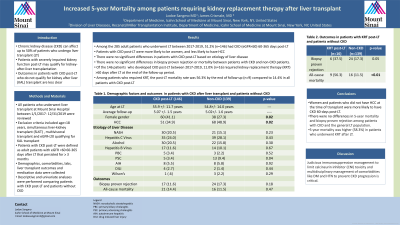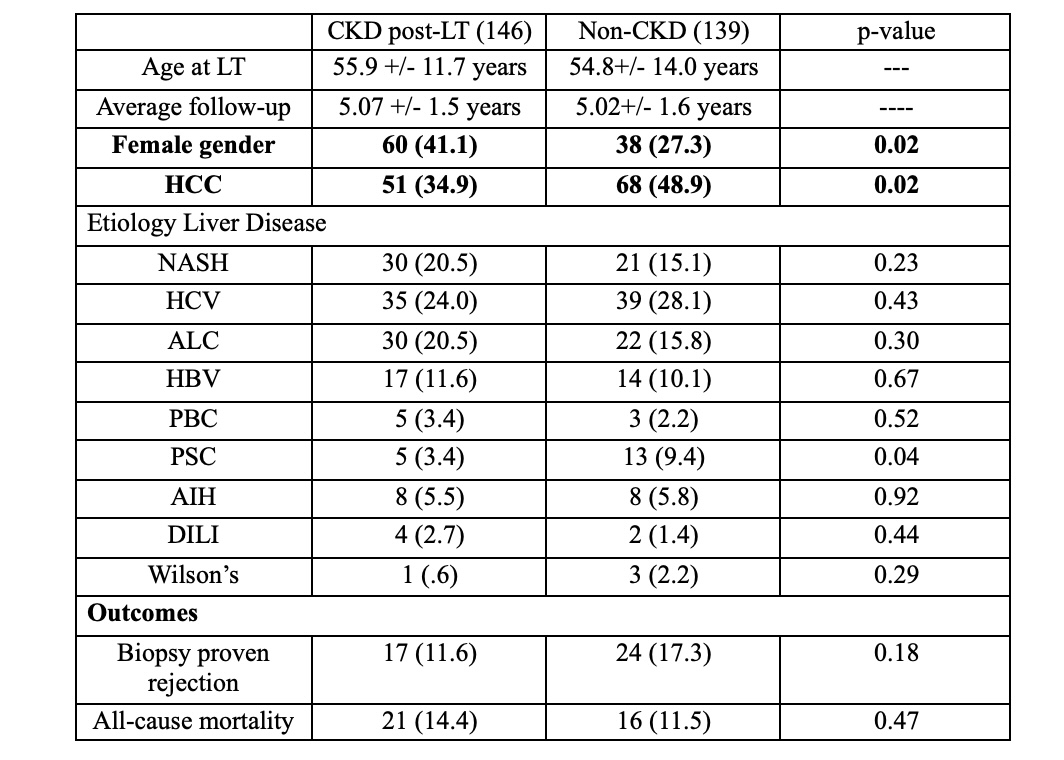Sunday Poster Session
Category: Liver
P1143 - Increased 5-Year Mortality Among Patients Requiring Kidney Replacement Therapy After Liver Transplant
Sunday, October 27, 2024
3:30 PM - 7:00 PM ET
Location: Exhibit Hall E

Has Audio

Lodoe Sangmo, MD
Icahn School of Medicine at Mount Sinai
Long Island City, NY
Presenting Author(s)
Lodoe Sangmo, MD1, James Crismale, MD2
1Icahn School of Medicine at Mount Sinai, Long Island City, NY; 2Icahn School of Medicine at Mount Sinai, New York, NY
Introduction: Chronic kidney disease (CKD) can affect up to 50% of patients who undergo liver transplant (LT). While patients who undergo simultaneous liver-kidney transplant (SLKT) or kidney after liver (KAL) transplant generally have good renal function after, outcomes in patients with CKD post-LT who do not qualify for SLKT or KAL are less clear.
Methods: All patients who underwent live transplant at Mount Sinai Hospital between 1/1/2017- 12/31/2019 were reviewed. Exclusion criteria included age< 18 years, SLKT, multivisceral transplant and eGFR< 20 qualifying for KAL. Patients with CKD post-LT were defined as adult patients with eGFR >20 and < 60 60-365 days after LT that persisted for > 3 months. Demographics, comorbidities, labs, liver transplant outcomes and medication data were collected. Descriptive and univariate analyses were performed comparing patients with CKD post-LT and patients without CKD.
Results: Among the 285 adult patients who underwent LT between 2017-2019, 51.2% (n=146) had CKD post-LT. Patients with CKD post-LT were more likely to be women, and less likely to have HCC. The mean follow-up time post-LT was 5.07 +/- 1.5 years in patients with CKD and 5.02 +/- 1.6 years in patients without CKD. There were no significant differences in biopsy proven rejection or mortality between patients with CKD and non-CKD patients. Of the 146 patients with CKD who underwent LT between 2017-2019, 11.0% (n=16) required kidney replacement therapy (KRT) >60 days after LT at the end of follow-up. Among patients who required KRT, the post-LT mortality rate was 56.3% by the end of follow-up (n=9) compared to 14.4% in all patients with CKD post-LT. 75% (n=12) of patients requiring KRT were listed for kidney transplant (KRT). Of these patients, two patients underwent kidney transplant (16.7%), three patients remained actively listed (25%), and seven patients (58.3%) were delisted or inactive at the end of follow-up.
Discussion: While 5-year mortality among patients with CKD is comparable to overall 5-yr survival in the general LT population, it appears to be higher among those who require KRT. Judicious immunosuppression management to limit CNI toxicity and multidisciplinary management of comorbidities like DM and HTN to prevent CKD progression is critical.

Disclosures:
Lodoe Sangmo, MD1, James Crismale, MD2. P1143 - Increased 5-Year Mortality Among Patients Requiring Kidney Replacement Therapy After Liver Transplant, ACG 2024 Annual Scientific Meeting Abstracts. Philadelphia, PA: American College of Gastroenterology.
1Icahn School of Medicine at Mount Sinai, Long Island City, NY; 2Icahn School of Medicine at Mount Sinai, New York, NY
Introduction: Chronic kidney disease (CKD) can affect up to 50% of patients who undergo liver transplant (LT). While patients who undergo simultaneous liver-kidney transplant (SLKT) or kidney after liver (KAL) transplant generally have good renal function after, outcomes in patients with CKD post-LT who do not qualify for SLKT or KAL are less clear.
Methods: All patients who underwent live transplant at Mount Sinai Hospital between 1/1/2017- 12/31/2019 were reviewed. Exclusion criteria included age< 18 years, SLKT, multivisceral transplant and eGFR< 20 qualifying for KAL. Patients with CKD post-LT were defined as adult patients with eGFR >20 and < 60 60-365 days after LT that persisted for > 3 months. Demographics, comorbidities, labs, liver transplant outcomes and medication data were collected. Descriptive and univariate analyses were performed comparing patients with CKD post-LT and patients without CKD.
Results: Among the 285 adult patients who underwent LT between 2017-2019, 51.2% (n=146) had CKD post-LT. Patients with CKD post-LT were more likely to be women, and less likely to have HCC. The mean follow-up time post-LT was 5.07 +/- 1.5 years in patients with CKD and 5.02 +/- 1.6 years in patients without CKD. There were no significant differences in biopsy proven rejection or mortality between patients with CKD and non-CKD patients. Of the 146 patients with CKD who underwent LT between 2017-2019, 11.0% (n=16) required kidney replacement therapy (KRT) >60 days after LT at the end of follow-up. Among patients who required KRT, the post-LT mortality rate was 56.3% by the end of follow-up (n=9) compared to 14.4% in all patients with CKD post-LT. 75% (n=12) of patients requiring KRT were listed for kidney transplant (KRT). Of these patients, two patients underwent kidney transplant (16.7%), three patients remained actively listed (25%), and seven patients (58.3%) were delisted or inactive at the end of follow-up.
Discussion: While 5-year mortality among patients with CKD is comparable to overall 5-yr survival in the general LT population, it appears to be higher among those who require KRT. Judicious immunosuppression management to limit CNI toxicity and multidisciplinary management of comorbidities like DM and HTN to prevent CKD progression is critical.

Figure: Table 1. Demographic factors and outcomes in patients with CKD after liver transplant and patients without CKD
Disclosures:
Lodoe Sangmo indicated no relevant financial relationships.
James Crismale indicated no relevant financial relationships.
Lodoe Sangmo, MD1, James Crismale, MD2. P1143 - Increased 5-Year Mortality Among Patients Requiring Kidney Replacement Therapy After Liver Transplant, ACG 2024 Annual Scientific Meeting Abstracts. Philadelphia, PA: American College of Gastroenterology.
